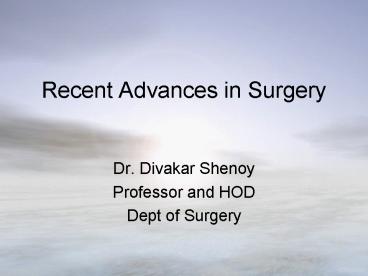Recent Advances in Surgery - PowerPoint PPT Presentation
1 / 32
Title:
Recent Advances in Surgery
Description:
Advances have resulted from simple, painstaking clinical ... feedback(haptic) system, which replaces the tactile sensibilities and restores dexterity ... – PowerPoint PPT presentation
Number of Views:3508
Avg rating:3.0/5.0
Title: Recent Advances in Surgery
1
Recent Advances in Surgery
- Dr. Divakar Shenoy
- Professor and HOD
- Dept of Surgery
2
- Surgery has undergone a sea of change in recent
times. - Advances have resulted from simple, painstaking
clinical observations on one hand and highly
sophisticated scientific methods on the other. - These advances have changed the way surgeries are
done, and are shaping the future of Surgery
3
The Harmonic scalpel
- The Harmonic Scalpel is an ultrasonic cutting and
coagulation surgical device - it uses ultrasonic energy to vibrate its blade at
55,000 cycles per second. - Invisible to the naked eye, the vibration
transfers energy to the tissue, providing
simultaneous cutting and coagulation. - It thus cuts and coagulates by using lower
temperatures than those used by electro surgery
or lasers.
4
- The Harmonic scalpel
5
- Harmonic scalpel adapted for endoscopic
procedures
6
- It is used for surgical procedures in which
soft-tissue incisions will be made and in which
bleeding control and minimal lateral thermal
damage to tissue are desired. - When compared with electro surgery, - fewer
instrument exchanges - less tissue charring and dessication
- - visibility in the surgical field is improved.
7
The Margin-probe
- This is an intraoperative probe used in breast
lumpectomy procedures to aid in intraoperative
margin assessment. - The instrument has two components a disposable
probe unit and an external console unit.
The probe unit
8
- The measured site is a 7mm wide by 1mm deep,
coin-shaped slice of tissue against which the
sensor, at the tip of the probe, is pressed. - It provides surgeons with a simple, real-time,
audible and visual indication of the tissue's
malignancy status, that is, cancerous vs. normal.
9
- The Margin Probe
10
Robotics
- Robotics is rapidly developing in surgery
- The machine acts as a remote extension of the
surgeon as a master-slave manipulator - The goal is to restore the tactile cues and
intuitive dexterity of the surgeon, with a force
feedback(haptic) system, which replaces the
tactile sensibilities and restores dexterity
11
- Effector arms of da Vinci surgical
system. The attached instruments are controlled
by the surgeon, who sits at an adjacent console.
12
- Effector tips of the da Vinci
surgical system incorporate miniature wrists
that allow them to mimic any movement made by the
surgeon at the control console
13
- Motion scaling software is used to translate
large natural movements to extremely precise
micro movements. - Surgeons can immediately observe the instruments
in the patient's body respond to the movements of
their hands on the handles
14
The surgeon
15
The Surgery
16
- This technology is also being used in open
procedures that require extreme precision, for
example, microvascular anastomosis and nerve
repair. - In such settings, the robot can enhance the
surgeons skills by eliminating physiological
tremors.
17
Stereotaxy
- Stereotactic surgery or
- stereotaxy is a minimally-
- invasive form of surgical intervention which
makes use of a three-dimensional coordinates
system to locate small targets inside the body
and to perform some action on them (Biopsy,etc). - "Stereotactic" in Greek means movement in space.
18
- Its applications have been used mainly in brain
surgery though any organ system inside the body
can be subjected to stereotactic surgery.
19
Stereotactic brain biopsy being taken. Probe can
be visualised.(arrows)
20
- Brain lesion biopsy being taken with
stereotactic frame in-situ
21
Keratinocyte Culture
- In extensive burns, there is a dire need for
normal healthy skin for transplantation onto the
damaged areas. - This need was being met by harvesting healthy
skin from undamaged areas of the body. - In extensive burns, the area that has escaped
damage is little and is not sufficient.
22
- This need is being met by culturing
keratinocytes( cells present in normal skin) and
transplanting them onto the damaged areas. - The keratinocytes are first transferred onto
suitable media where they proliferate
Keratinocyte culture with a magnified view of
proliferating keratinocytes
23
- The keratinocyte rich matrics are then
transplanted onto the wounds where they are
incorporated into the healing process
A magnified view of cultured keratinocytes
proliferating across the culture matrix
24
- A Sheet of cultured keratinocytes ready for
transfer and clinical use
25
Cardio-pulmonary bypass
- Cardiopulmonary bypass (CPB) is a technique that
temporarily takes over the function of the heart
and lungs during surgery, maintaining the
circulation of blood and the oxygen content of
the body. - The development of the cardiopulmonary bypass
machine has revolutionized cardiothoracic surgery
and open heart surgery
26
(No Transcript)
27
- The Heart- Lung Machine
28
- The Heart-Lung machine in use during heart
surgery
29
The Ventricular Assist Device
- A Ventricular assist device, or VAD, is a
mechanical device that is used to partially or
completely replace the function of a failing
heart. - Blood from the ventricle passes through a pump
and thence through a - tube to the aorta.
30
- Using these Ventricle Assist Devices, the amount
of blood pumped out by the heart is increased and
the work load on an already failing heart is
decreased.
A VAD and its position in the heart
illustrated
31
A VAD in-situ.
32
Thank You































